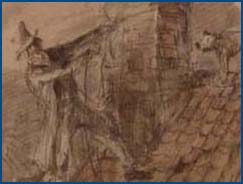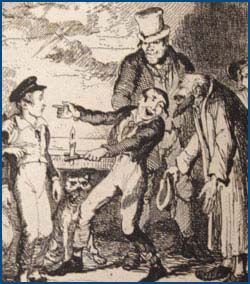|
When Is a Book Not a Book? Oliver Twist in Context Section 3. The Generic Ambiguities of Serial FictionSerialization also tends to deconstruct the genre of fiction. Oliver Twist, beginning as a Mudfog paper, starts as a further instance of the articles and tales Charles Dickens had written for the Monthly Magazine and the Morning and Evening Chronicle; these in turn were partly based on sketches of the city by other journalists and graphic artists. Like Dickens's The Old Curiosity Shop, Oliver Twist begins more like a short story than an extended fiction. Like Pickwick, the Mudfog papers claim affinity with Parliamentary reports, memoirs, and posthumous papers. In Bentley's Miscellany, the installments of Oliver Twist are interspersed with other serials and with essays and poems about everything from angling in the days of Izaac Walton to an ode upon the birthday of Princess Victoria. It was not unusual, in these settings, for periodical stories to incorporate poems, criticism, philosophy, history, travelogues, or even musical scores. Most notably, many magazine fictions articulate an affinity with drama. Oliver Twist is confessedly constructed according to melodramatic principles: "It is the custom on the stage," Boz the narrator tells us, "in all good, murderous melodramas, to present the tragic and the comic scenes in as regular alternation as the layers of red and white in a side of streaky, well-cured bacon." The story is situated among many articles about the theatre: the opening number of Bentley's Miscellany starts with an essay by journalist Theodore Hook on English playwright and theatre manager George Colman the Younger. The novel employs a great deal of theatrical characterization and dialogue, such as Sikes's stagy "Wolves tear your throats!" Like other serials, Oliver Twist was on the boards before it was bound in paper boards, even before it was completely written: the first dramatization, by Gilbert À Beckett, appeared after only half the installments had been composed. Cruikshank increasingly directed the illustrations toward their theatrical realization, and for Dickens the prospects, and retrospects, of dramatizing the story significantly affected the text's design. Knowing, as he did about half the way through composition and publication, that actor-manager Frederick Yates wanted to stage the story before it was completed in print, Dickens may have enhanced the role of Fagin in the concluding chapters in anticipation of the dramatization. Certainly Dickens wanted his serial readers to respond viscerally, as if in a theatre. Further, Bentley's Miscellany is itself refigured as a stage rather than as a magazine or sheets of printed paper bound up as a "material whole": the "Editor's Address" on the completion of the first half-year is couched as the manager's stage address at the end of a theatrical season. Nor is this the end of the generic ambiguities of serial fictions. As in Oliver Twist's case, the graphic tradition often played a prominent role; this story is subtitled a "progress," a term denoting a sort of life contour, physical and moral, often told through a series of pictures. And midway through the text's composition, Dickens renegotiated his author's contracts with Richard Bentley, who was not only the proprietor of the magazine but also the stipulated publisher of Dickens's next two novels. That renegotiation changed the serialized fiction Oliver Twist from the fulfillment of a contractual monthly contribution of 16 pages for the Miscellany into a novel, to be released in three volumes half a year before the serial dragged to a close in the magazine. So even in format Oliver Twist was neither conceived of nor produced as a novel for much of its initial appearance. Its affinities with theatre, pictures, sketches, journalism, short stories, and Parliamentary proceedings are at least as influential in its initial stages as the generic boundaries of the novel. Serial fictions interweave with other genres in immediate, material ways that their later repackaging into self-contained novels conceals.
|

